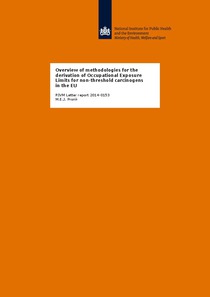Overview of methodologies for the derivation of Occupational Exposure Limits for non-threshold carcinogens in the EU
"Workers can be exposed to chemical agents. In order to assure that this exposure will not result in adverse effects on health, occupational exposure limits (OELs) are established. In general this means that a safe level of exposure via the airborne route is set such that this exposure, even wh...
| Main Author: | |
|---|---|
| Institution: | ETUI-European Trade Union Institute |
| Format: | TEXT |
| Language: | English |
| Published: |
Bilthoven
2014
RIVM |
| Subjects: | |
| Online Access: | https://www.labourline.org/KENTIKA-19399293124911174759-overview-of-methodologies-for-.htm |
| _version_ | 1771659893512601600 |
|---|---|
| author | Pronk, M.E.J. |
| author_facet | Pronk, M.E.J. |
| collection | Library items |
| description | "Workers can be exposed to chemical agents. In order to assure that this exposure will not result in adverse effects on health, occupational exposure limits (OELs) are established. In general this means that a safe level of exposure via the airborne route is set such that this exposure, even when repeated on a regular basis throughout a working life, will not lead to adverse effects on the health of exposed persons and/or their progeny at any time.
For the group of carcinogens which directly damages DNA, a different approach is needed. For these so-called non-threshold carcinogens it is not possible to derive a level of exposure at which no adverse health effects may occur; it must be assumed that any level of exposure, however small, might carry some finite risk. Occupational exposure limits for this type of substances are derived using a 'risk level': the number of additional cases of cancer due to exposure to such substances. The Ministry of Social Affairs and Employment requested the RIVM to make an inventory of the methodologies which are applied in the EU to derive OELs for non-threshold carcinogens.
It was found that there are many similarities, but also some differences. One of the similarities is that the methodologies are based on similar principles. All apply similar general criteria for quality and adequacy of the data selected to derive the limits. All also prefer the use of human data above the use of animal data, but recognize that in most cases these will not be available or will not form a sufficient basis on their own.
Differences observed in occupational exposure limits for non-threshold carcinogens are largely due to differences in cancer risk levels used. Other sources for the differences are the choice for the animal exposure levels which causes the adverse effect, and uncertainty factors applied in the extrapolation from animals to humans. When at a later stage other considerations such as socio-economic or technical feasibility are also taken into account, these may additionally lead to differences in the final occupational exposure limits." |
| format | TEXT |
| geographic | Germany France Poland Netherlands |
| id | 19399293124911174759_c1349cc03fd64485b2ac53e6d7ee9841 |
| institution | ETUI-European Trade Union Institute |
| is_hierarchy_id | 19399293124911174759_c1349cc03fd64485b2ac53e6d7ee9841 |
| is_hierarchy_title | Overview of methodologies for the derivation of Occupational Exposure Limits for non-threshold carcinogens in the EU |
| language | English |
| physical | 27 p. Digital |
| publishDate | 2014 |
| publisher | Bilthoven RIVM |
| spellingShingle | Pronk, M.E.J. threshold limit values determination of exposure limits carcinogens methodology comparison Overview of methodologies for the derivation of Occupational Exposure Limits for non-threshold carcinogens in the EU |
| thumbnail | https://www.labourline.org/Image_prev.jpg?Archive=133198095137 |
| title | Overview of methodologies for the derivation of Occupational Exposure Limits for non-threshold carcinogens in the EU |
| topic | threshold limit values determination of exposure limits carcinogens methodology comparison |
| url | https://www.labourline.org/KENTIKA-19399293124911174759-overview-of-methodologies-for-.htm |

